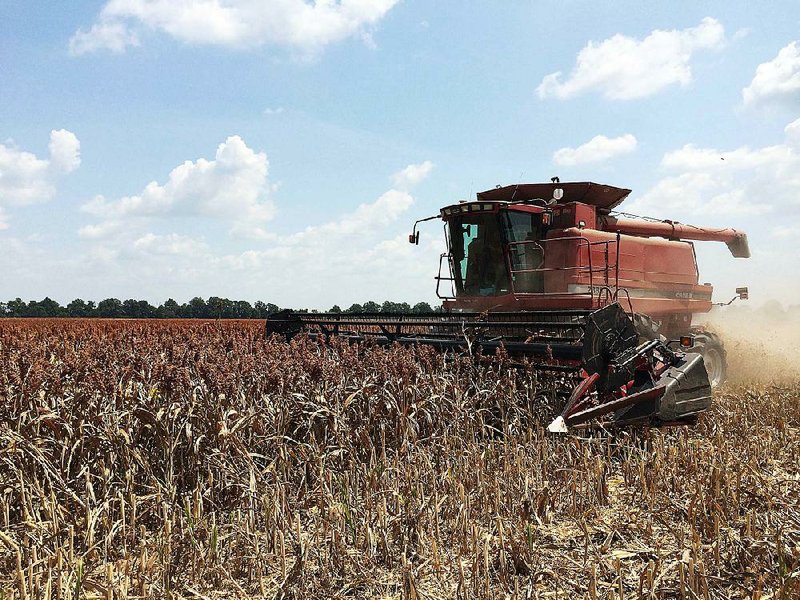Arkansas farmers are taking advantage of an extended deadline to update yield histories and establish base acreage for their crops as new crop-loss rules set by the 2014 farm bill come into play.
Growers initially had until Feb. 27 to meet with the U.S. Department of Agriculture's Farm Service Agency to file the reports. However, the USDA pushed the deadline back to March 31 to give farmers around the nation more time, since this year's decisions can't be changed for several years under current federal law.
Linda Newkirk, executive director of the Farm Service Agency in Arkansas, expects enrollments will continue right up to the deadline.
"The producers are coming in and asking more questions," Newkirk said. "They're reviewing their data and using their time to review their options. It's just taking a little bit longer for them to get to that point."
Newkirk said the current enrollment marks the first opportunity producers have had to update historical yield figures in several years. She said that once the deadline passes, no changes will be allowed, and reported figures will remain in effect through 2018.
Given the complexity, "we're trying to get everybody we can in that door," she said.
The 2014 farm bill eliminated direct payments to farmers. Instead, growers must file acreage and yield reports and then choose one of two programs -- Agricultural Risk Coverage or Price Loss Coverage -- to cover crop losses if disaster strikes.
"It took some time to understand not only what decisions had to be made, but what information was required to make those decisions," Scott Stiles, an economist with the University of Arkansas system Division of Agriculture, wrote in an email. "Making a one-time decision that is influenced by future commodity prices is not easy and that has likely made the sign-up decisions more complicated and thus slower."
Stiles, who has been working with producers on enrollment, said that as of Wednesday, Arkansas was 63 percent complete regarding base acreage and yield updates and 30 percent complete on program selection, slightly behind the national averages of 81 percent and 51 percent. The exact number of enrollees was unavailable, Newkirk said.
Stiles said most of the base acreage in Arkansas is devoted to major crops such as rice, soybeans, corn and wheat. While cotton is a major crop in the state, it's no longer a covered commodity under the 2014 farm bill and is now considered part of the "generic base."
Under the new farm bill, growers must decide how to allocate farmland for various crops, which sets the base acreage, and then choose a crop loss protection program.
Price Loss Coverage covers losses if commodity prices drop below established reference prices. Agriculture Risk Coverage covers lost revenue for a covered commodity relative to a revenue guarantee. The programs combine elements of previous programs from the Farm Service Agency, according to the USDA, and either program can be applied to entire farms, or on a crop-by-crop basis.
If growers don't update their yield history or base acres, then the agency will use existing yield and base figures.
Stiles said it's taking producers time to gather the information they need to make those decisions, as well as understand the nature of those decisions. He said producers have to review yield and planting records dating back to 2008 and, in some cases, contact past tenants or farm operators for acreage they've added over time.
He said choosing between Agriculture Risk Coverage and Price Loss Coverage decision is the most complicated, since it carries the most uncertainty over time and it can't be changed over the life of the current farm bill.
Given the ups and downs of commodity prices, "farmers and landowners don't know today the exact amount of future benefit (if any) they'll receive from either ... program," Stiles said.
The University of Arkansas system Division of Agriculture's Cooperative Extension Service has been working with growers to help them sort through the process.
It has held both webinars and laboratories to provide information to growers and help them submit the necessary information to the Farm Service Agency. It has scheduled four more hands-on sessions to help producers use a computerized tool developed by Texas A&M to assess their needs.
One industry group, Arkansas Rice Farmers, welcomed the extension after it was announced by Agriculture Secretary Tom Vilsack.
"This additional month will help more of our producers submit the most accurate information on their yield histories and base acreage," Dow Brantley, chairman of Arkansas Rice Farmers, said in a release.
The USDA said that it sent out nearly 3 million postcards to growers nationwide and that more than 4,100 training sessions have been held to explain the program.
Stiles said growers are anxious to get the enrollment behind them.
"Once March rolls around, the focus turns to fieldwork, especially if temperatures warm," he wrote. "Bottom line, planting is on the radar, and the producer's attention is shifting to the 2015 crop."
SundayMonday Business on 03/08/2015
